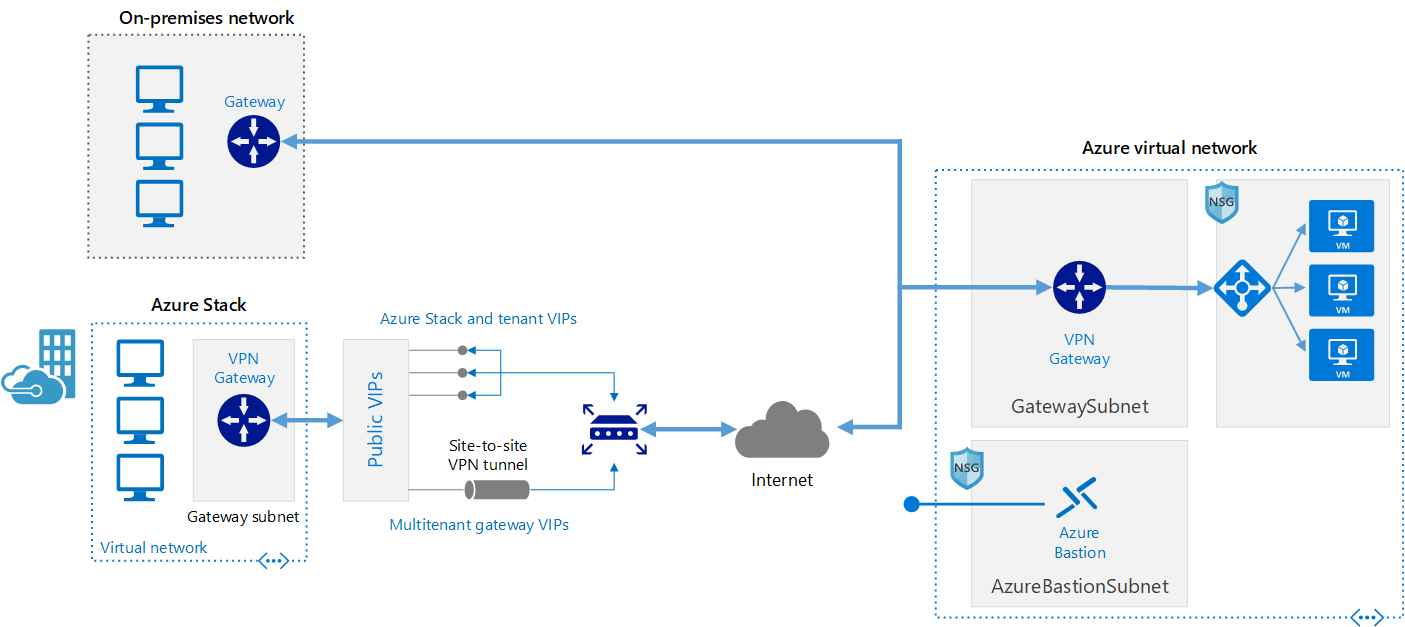Azure VPN Gateways
Azure VPN Gateway instances are deployed in a dedicated subnet of the virtual network and enable the following connectivity:
- Connect on-premises datacenters to virtual networks through a site-to-site connection.
- Connect individual devices to virtual networks through a point-to-site connection.
- Connect virtual networks to other virtual networks through a network-to-network connection.
When you deploy a VPN gateway, you specify the VPN type: either policy-based or route-based. The main difference between these two types of VPNs is how traffic to be encrypted is specified. In Azure, both types of VPN gateways use a pre-shared key as the only method of authentication. Both types also rely on Internet Key Exchange (IKE) in either version 1 or version 2 and Internet Protocol Security (IPSec). IKE is used to set up a security association (an agreement of the encryption) between two endpoints. This association is then passed to the IPSec suite, which encrypts and decrypts data packets encapsulated in the VPN tunnel.
Policy-based VPN gateways specify statically the IP address of packets that should be encrypted through each tunnel. This type of device evaluates every data packet against those sets of IP addresses to choose the tunnel where that packet is going to be sent through.
With route-based gateways, IPSec tunnels are modeled as a network interface or virtual tunnel interface. IP routing (either static routes or dynamic routing protocols) decides which one of these tunnel interfaces to use when sending each packet. Route-based VPNs are the preferred connection method for on-premises devices. They’re more resilient to topology changes such as the creation of new subnets.
Use a route-based VPN gateway if you need any of the following types of connectivity: Connections between virtual networks Point-to-site connections Multisite connections Coexistence with an Azure ExpressRoute gateway
Before you can deploy a VPN gateway, you’ll need some Azure and on-premises resources.
- Virtual Network
- Gateway Subnet
- Public IP Address
- Local network gateway
- Virtual network gateway
- Connection
To connect your datacenter to a VPN gateway, you’ll need these on-premises resources:
- A VPN device that supports policy-based or route-based VPN gateways
- A public-facing (internet-routable) IPv4 address
By default, VPN gateways are deployed as two instances in an active/standby configuration, even if you only see one VPN gateway resource in Azure. When planned maintenance or unplanned disruption affects the active instance, the standby instance automatically assumes responsibility for connections without any user intervention. Connections are interrupted during this failover, but they’re typically restored within a few seconds for planned maintenance and within 90 seconds for unplanned disruptions.
With the introduction of support for the BGP routing protocol, you can also deploy VPN gateways in an active/active configuration. In this configuration, you assign a unique public IP address to each instance. You then create separate tunnels from the on-premises device to each IP address. You can extend the high availability by deploying an additional VPN device on-premises.
Another high-availability option is to configure a VPN gateway as a secure failover path for ExpressRoute connections.
In regions that support availability zones, VPN gateways and ExpressRoute gateways can be deployed in a zone-redundant configuration. This configuration brings resiliency, scalability, and higher availability to virtual network gateways. Deploying gateways in Azure availability zones physically and logically separates gateways within a region while protecting your on-premises network connectivity to Azure from zone-level failures. These gateways require different gateway SKUs and use Standard public IP addresses instead of Basic public IP addresses.
This reference architecture shows how to extend a network from on premises or from Azure Stack into an Azure virtual network, using a site-to-site virtual private network (VPN). Traffic flows between the on-premises network and Azure through an IPSec VPN tunnel or through the Azure Stack multitenant VPN gateway.




